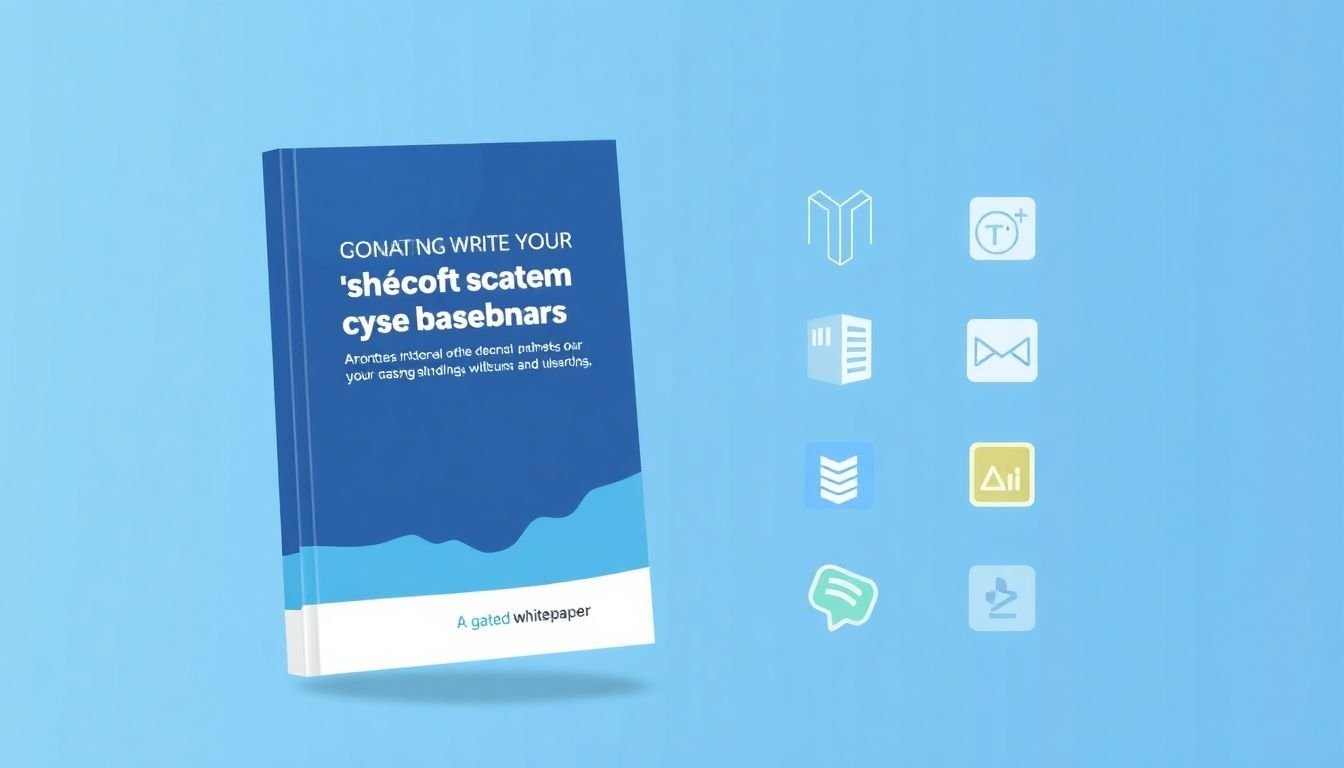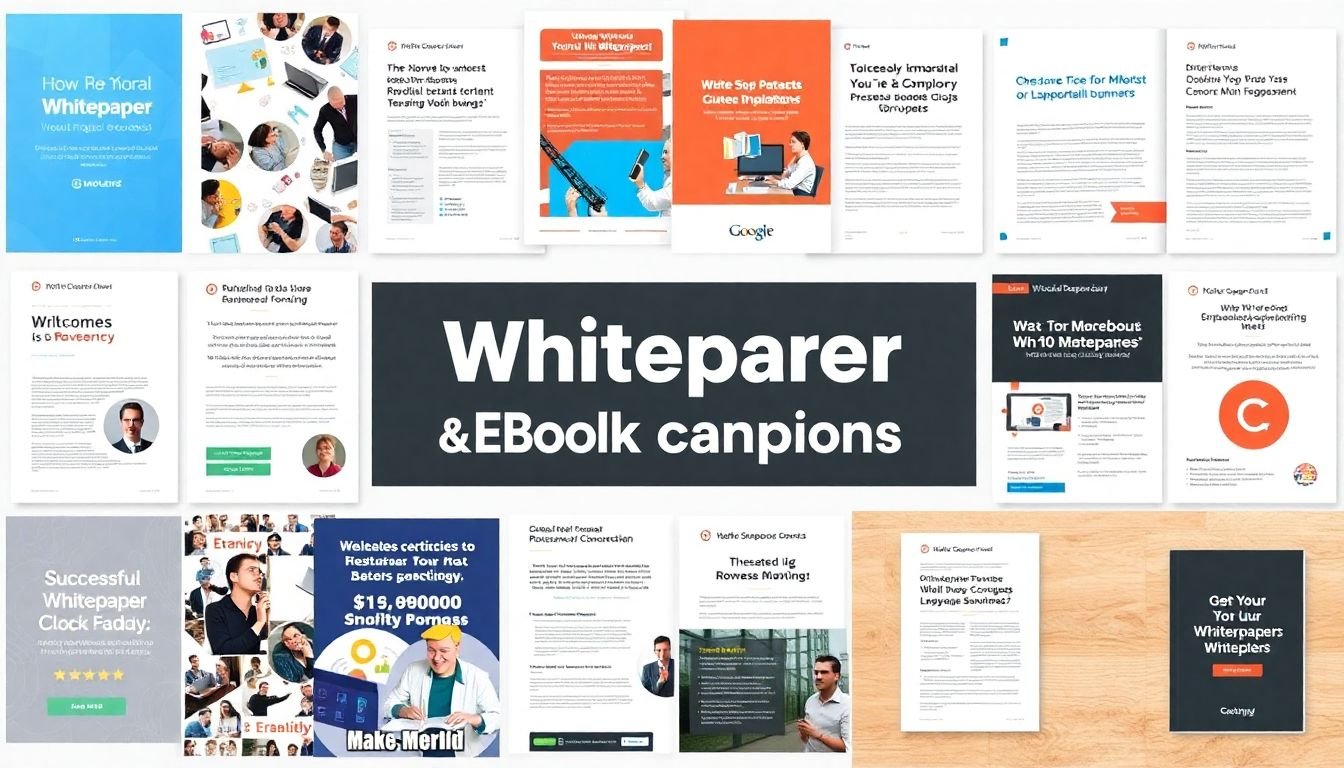In today’s digital age, standing…

Table of Contents
Did you know that 79% of marketing leads are never converted into sales due to lack of nurturing?
In today’s digital age, standing out in the crowded marketing landscape is no easy feat. But what if there was a way to not only capture your audience’s attention but also guide them through your marketing funnel, nurturing them into qualified leads? Enter: Whitepapers and eBooks as lead magnets.
You might be wondering, ‘What are lead magnets, and how can they transform my content strategy?’ Well, imagine offering your audience something so valuable, so irresistible, that they’re willing to share their personal information in exchange. That’s a lead magnet. And whitepapers and eBooks, when crafted strategically, can be powerful ones.
In this comprehensive guide, we’re going to delve into the art of using whitepapers and eBooks as lead magnets to optimize your marketing funnel. By the end of this article, you’ll understand:
- The role of lead magnets in your marketing funnel
- How to create compelling whitepapers and eBooks
- Strategies to promote and distribute your lead magnets
- Best practices for converting leads into customers
So, are you ready to turn your content into a powerful lead generation machine? Let’s dive in!
Unlocking the Potential of Long-Form Content in Your Content Strategy
In the digital age, where bite-sized information reigns supreme, the power of long-form content often goes unnoticed. Yet, it is precisely this format that can unlock a treasure trove of benefits for your content strategy. Long-form content, typically defined as articles or posts exceeding 1000 words, allows for a depth of exploration that short-form content simply cannot match. It provides an opportunity to delve into complex topics, present detailed analyses, and tell compelling stories that engage readers on a deeper level. Moreover, search engines favor long-form content, as it tends to provide more value to users, leading to better visibility and organic reach. This format also encourages social sharing, with readers more likely to share in-depth, informative pieces with their networks. Furthermore, long-form content can establish your brand as an authority in your niche, as it demonstrates a commitment to thorough research and comprehensive information. So, why not unlock the potential of long-form content in your content strategy? It might just be the key to engaging your audience, boosting your SEO, and solidifying your brand’s reputation.

Understanding Lead Magnets in Marketing
In the dynamic world of marketing, the term ‘lead magnet’ is not just a buzzword, but a powerful tool that can significantly enhance your marketing strategy. A lead magnet, in essence, is an irresistible offer or incentive that marketers use to attract potential customers, or ‘leads’, to provide their contact information in exchange for a valuable resource. The purpose of a lead magnet is twofold: firstly, it entices prospects to share their contact details, enabling businesses to build their email list and nurture leads through targeted communication. Secondly, it positions the brand as a thought leader, providing valuable content that addresses the pain points or interests of the target audience.
Lead magnets come in various shapes and sizes, each tailored to cater to different types of audiences and their unique needs. One of the most popular and effective types of lead magnets are whitepapers and eBooks. Whitepapers, typically, are in-depth reports that provide a comprehensive analysis of a particular topic, often backed by data and research. They are ideal for B2B marketers targeting a professional audience who value detailed, well-researched information. On the other hand, eBooks are longer-form content that can be a collection of blog posts, a comprehensive guide, or a fictional story related to your brand. They are perfect for engaging a wider audience, including both B2B and B2C markets.
To create an effective whitepaper or eBook as a lead magnet, consider the following steps:
- Identify your target audience and understand their needs and interests.
- Choose a topic that resonates with your audience and provides value.
- Ensure your content is well-researched, informative, and engaging.
- Design your lead magnet in a visually appealing and easy-to-read format.
- Promote your lead magnet through various channels, such as your website, social media, email marketing, and PPC campaigns.
By offering valuable content like whitepapers and eBooks as lead magnets, you’re not only attracting potential customers but also building trust and credibility with your audience. This, in turn, can significantly improve your marketing strategy’s effectiveness and drive business growth.

The Role of Whitepapers and eBooks in the Marketing Funnel
In the dynamic landscape of digital marketing, whitepapers and eBooks serve as powerful tools that guide prospects through the marketing funnel, particularly in the awareness and consideration stages. Let’s delve into their roles and how they facilitate this journey.
The marketing funnel, a visual representation of the customer journey, is divided into several stages: awareness, consideration, decision, retention, and advocacy. Whitepapers and eBooks primarily shine in the first two stages, helping to attract, engage, and educate potential customers.
In the awareness stage, these long-form content pieces play a pivotal role in establishing thought leadership and raising brand visibility. They provide in-depth, valuable information that addresses pain points and offers solutions, drawing in prospects who are just beginning to explore their options. For instance, a whitepaper on ‘The Future of AI in Marketing’ can attract tech-savvy marketers looking to stay ahead of the curve.
Once prospects have entered the consideration stage, whitepapers and eBooks continue to nurture them with detailed, comparative information. They can help prospects understand how your product or service compares to competitors, or how it can be integrated into their existing systems. For example, an eBook titled ‘How Our CRM Integrates with Your Existing Tech Stack’ can reassure prospects and move them closer to making a decision.
Moreover, these content pieces can be gated, requiring prospects to share their contact information in exchange for access. This not only helps build your email list but also allows you to track engagement and tailor future communications based on their interests. It’s a win-win: prospects gain valuable insights, and you gain valuable data.
In essence, whitepapers and eBooks are not just static content; they are strategic assets that can significantly influence the buyer’s journey. They help prospects self-educate, compare options, and ultimately, make informed decisions. By leveraging these tools effectively, marketers can guide prospects smoothly through the awareness and consideration stages, moving them further down the marketing funnel.

Crafting Compelling Whitepapers
Crafting a compelling whitepaper is an art that combines thorough research, engaging storytelling, and strategic design. Let’s embark on this journey, step by step.
Choosing a Topic:
Begin by selecting a topic that aligns with your brand’s expertise and your audience’s interests. It should be specific, timely, and valuable to your readers. Consider trends, challenges, or solutions in your industry. For instance, if you’re a tech company, you might choose ‘The Impact of AI on Cybersecurity in 2023’.
Conducting Research:
Once you’ve zeroed in on a topic, it’s time to dive deep into research. This involves gathering data from reliable sources, understanding your audience’s pain points, and identifying key insights. Remember, your whitepaper should provide unique value, so avoid regurgitating common knowledge. Instead, aim to offer fresh perspectives, case studies, or data-driven insights.
Structuring the Content:
- A well-structured whitepaper guides readers seamlessly through complex information. Here’s a tried-and-tested structure:
Introduction:
- Hook your readers with a compelling opening that sets the stage for the rest of the paper.
Problem Statement:
- Clearly define the problem your whitepaper will address.
Solution:
- Present your solution, backed by data, case studies, or expert opinions.
Conclusion:
- Summarize your findings and reiterate the value of your solution.
References:
Cite all the sources you’ve used to maintain academic integrity.
Keep each section concise and focused on a single idea.
Designing the Layout:
- A visually appealing layout enhances readability and engagement. Here are some design tips:
- Use a clean, professional font that’s easy to read.
- Break up text with headings, subheadings, bullet points, and numbered lists.
- Include relevant charts, graphs, or images to illustrate your points.
- Ensure your design aligns with your brand’s style guide.
- Optimize for both print and digital formats.
Lastly, don’t forget to proofread for grammar, punctuation, and spelling errors. A polished whitepaper signals professionalism and attention to detail.
Crafting a compelling whitepaper takes time and effort, but the result is a powerful tool that educates, engages, and converts. So, roll up your sleeves, and let’s get started!

Creating Engaging eBooks
Creating engaging eBooks is an art that combines compelling content with digital-friendly formatting. Let’s embark on a journey to craft eBooks that captivate readers and make the most of digital platforms.
First, choose a topic that resonates with your target audience. It could be a subject you’re passionate about, or a niche that needs quality content. Once you’ve found your topic, conduct thorough research to ensure your eBook offers unique insights and value.
Next, outline your eBook. A well-structured outline serves as a roadmap, keeping your writing focused and coherent. Start with a captivating introduction that hooks readers and sets the tone for your eBook. Then, break down your content into clear, manageable chapters. Each chapter should focus on a specific aspect of your topic, building towards a satisfying conclusion.
Now, it’s time to write. Remember, engaging eBooks are not just about the information they contain, but also how that information is presented. Use a conversational tone to connect with readers. Break up text with subheadings, bullet points, and lists to improve readability. Incorporate relevant examples, anecdotes, and visuals to illustrate your points.
Formatting is crucial for digital consumption. Use a clean, easy-to-read font, and adjust line spacing and margins to create a comfortable reading experience. Make sure your eBook is optimized for various devices and screen sizes. Use hyperlinks to connect readers to additional resources, and consider including interactive elements like quizzes or polls to enhance engagement.
Finally, don’t forget to proofread and edit your eBook. Typos, grammatical errors, and awkward phrasing can detract from your message and frustrate readers. Consider hiring a professional editor or using editing tools to polish your work.
Creating engaging eBooks is a process that requires careful planning, creative writing, and meticulous attention to detail. But with the right approach, you can produce digital books that inform, inspire, and entertain.

Optimizing Whitepapers and eBooks for SEO
In the digital marketing landscape, lead magnets like whitepapers and eBooks play a pivotal role in attracting, engaging, and converting audiences. However, their effectiveness is often hindered by a lack of visibility. This is where Search Engine Optimization (SEO) steps in, transforming these valuable resources into powerful tools for driving organic traffic and generating leads.
SEO is not just about ranking higher on search engine results pages; it’s about making your content more discoverable to your target audience. For whitepapers and eBooks, this means ensuring they’re optimized for the keywords your ideal readers are using to find solutions to their problems or answers to their questions.
Keyword research is the first step in this optimization process. Tools like Google Keyword Planner, SEMrush, or Ahrefs can help you identify relevant, high-volume, and low-difficulty keywords. Once you’ve compiled a list, integrate these keywords naturally into your content, headings, and meta tags.
On-page optimization is another critical aspect. This involves optimizing your content’s structure, meta tags, headings, and URLs. Use your primary keyword in your title tag, meta description, and headings (H1, H2, H3, etc.). Ensure your content is well-structured, with clear headings and subheadings, making it easy for both users and search engines to understand.
Internal linking is also a powerful SEO strategy. Link to other relevant pages on your website from within your whitepaper or eBook. This helps search engines understand the context and relevance of your content, and it also improves user experience by providing additional resources.
In conclusion, optimizing whitepapers and eBooks for SEO is not about stuffing them with keywords or manipulating the system. It’s about making your content more accessible to your target audience. By conducting thorough keyword research, optimizing your on-page elements, and implementing a strategic internal linking structure, you can significantly improve the visibility and impact of your lead magnets.

Gating and Promoting Your Lead Magnets
In the digital marketing landscape, lead magnets are powerful tools that entice potential customers to share their contact information in exchange for valuable content. The process of requiring this information before accessing the content is known as ‘gating’ your lead magnet. This strategy, while seemingly restrictive, offers several benefits. Firstly, it allows you to build your email list, enabling direct communication with your audience. Secondly, it helps filter out less interested prospects, ensuring you’re left with a list of engaged, qualified leads. Lastly, it provides an opportunity to showcase your expertise and build trust with your audience. To maximize the potential of your whitepapers and eBooks, promoting them effectively is crucial. Here are some strategies to consider:
Email Marketing:
- Leverage your existing email list to promote your lead magnet. Segment your list based on interests and behaviors to ensure your promotion reaches the most relevant audience. Here’s a simple step-by-step process:
- Craft a compelling subject line that clearly communicates the value of your lead magnet.
- Personalize your email content to make it resonate with your audience.
- Include a clear call-to-action (CTA) button that links directly to your lead magnet landing page.
- Send follow-up emails to non-openers and those who didn’t convert to remind them about your offer.
Social Media:
- Platforms like LinkedIn, Twitter, and Facebook can help you reach a wider audience. Here’s how you can promote your lead magnet on these platforms:
- Share a sneak peek or key takeaway from your whitepaper or eBook to pique interest.
- Use relevant hashtags to increase the visibility of your posts.
- Engage with your audience by responding to comments and messages.
- Consider using paid social media ads to reach a larger, targeted audience.
Content Syndication:
- Partnering with third-party websites to syndicate your content can help you reach a larger audience. Here’s how you can do it:
- Identify websites that cater to your target audience and offer content syndication opportunities.
- Create a summary or excerpt of your lead magnet that can be published on these websites.
- Include a clear CTA in your syndicated content, directing readers to your lead magnet landing page.
- Monitor the performance of your syndicated content and engage with readers who interact with it.
By implementing these strategies, you can effectively gate and promote your lead magnets, driving more leads and growing your business.

Measuring the Success of Your Lead Magnets
Measuring the success of your lead magnets, such as whitepapers and eBooks, is a crucial step in refining your content strategy. Key Performance Indicators (KPIs) serve as your compass, guiding you towards understanding what’s working and what’s not. Let’s dive into the three most important KPIs to track.
The first KPI, conversion rate, is the percentage of visitors who download your lead magnet after landing on your landing page. A high conversion rate indicates that your offer is compelling and your targeting is on point. To calculate it, use the formula: (Number of Downloads / Number of Visitors) x 100.
Next, let’s talk about lead quality. Just because someone downloaded your whitepaper doesn’t mean they’re a qualified lead. To measure lead quality, consider the following steps:
- Score leads based on their fit with your ideal customer profile (ICP).
- Track the percentage of high-scoring leads that engage with your follow-up content or sales outreach.
- Monitor the conversion rate of these high-quality leads into paying customers.
By focusing on lead quality, you’ll ensure your sales team isn’t wasting time on leads that will never convert.
Lastly, cost per acquisition (CPA) is a vital KPI that helps you understand the cost of gaining a new customer. To calculate CPA, divide the total cost of your lead magnet campaign by the number of new customers acquired. This metric helps you optimize your budget and ensure you’re getting a positive return on investment (ROI).
Using these metrics, you can refine your content strategy by identifying which lead magnets resonate most with your audience, which topics attract high-quality leads, and where you can cut costs without sacrificing results. Regularly reviewing and adjusting your strategy based on these KPIs will help you create a content marketing machine that drives real business growth.

Case Studies: Whitepapers and eBooks in Action
In the dynamic world of digital marketing, whitepapers and eBooks have emerged as powerful tools for lead generation and thought leadership. Let’s delve into two compelling case studies that illustrate the effectiveness of these content formats as lead magnets.
The first case is that of HubSpot, a leading growth platform, which masterfully employed an eBook to capture leads and establish itself as an industry authority. HubSpot’s ‘State of Inbound’ report, an annual eBook, offers a comprehensive analysis of the inbound marketing landscape. To access this valuable resource, visitors are required to fill out a form, providing HubSpot with crucial lead information. The strategy has been a resounding success, with the eBook generating thousands of leads each year. Key takeaways from HubSpot’s approach include:
- Creating high-quality, insightful content that resonates with the target audience
- Offering the content in exchange for lead information
- Repurposing the content into smaller, shareable assets for wider reach
The second case study involves Marketo, a marketing automation software company, which used a whitepaper to drive leads and nurture them through the sales funnel. Marketo’s ‘Definitive Guide to Marketing Automation’ whitepaper provides an in-depth exploration of the topic, positioning Marketo as a thought leader. To access the whitepaper, visitors submit their contact details, becoming leads that Marketo can then nurture with targeted content. The results were impressive, with the whitepaper generating a significant number of marketing-qualified leads (MQLs) and contributing to Marketo’s growth. Lessons learned from Marketo’s strategy include:
- Developing long-form, authoritative content that addresses pain points and provides solutions
- Gating the content behind a lead capture form
- Integrating the lead magnet into a broader lead nurturing strategy
These case studies underscore the potency of whitepapers and eBooks as lead magnets. By offering valuable, engaging content in exchange for lead information, businesses can effectively drive growth and establish thought leadership.

Advanced Strategies: Repurposing and Updating Content
In the dynamic digital landscape, creating high-quality content is just the first step. Maximizing its lifespan and reach is where the real magic happens. Let’s delve into some advanced strategies to ensure your whitepapers and eBooks continue to engage, inform, and inspire your audience long after their initial publication.
Firstly, consider the power of repurposing. Your in-depth whitepapers and eBooks are treasure troves of valuable information that can be transformed into a myriad of formats to cater to different learning styles and preferences. Here’s how:
- Blog Posts: Break down your content into bite-sized, easily digestible blog posts. This not only extends the life of your content but also improves your SEO, as search engines love fresh, relevant content.
- Infographics: Visualize complex data or processes from your whitepaper or eBook into engaging infographics. These can be shared widely on social media, driving traffic back to your original content.
- Webinars: Transform your eBook or whitepaper into an interactive webinar. This allows you to engage directly with your audience, answer questions, and provide real-time insights.
Secondly, maintaining relevance is key in the ever-evolving digital world. Here’s how you can update your content to keep it fresh and engaging:
- Regular Updates: Schedule periodic updates to reflect changes in trends, technologies, or best practices. This shows your audience that you’re committed to keeping them informed and up-to-date.
- User-Generated Content: Incorporate feedback, comments, or questions from your audience. This not only updates your content but also fosters engagement and community.
- New Data or Case Studies: Add new data, statistics, or case studies to support your arguments and keep your content relevant and valuable.
By implementing these strategies, you’re not just creating content, you’re building a comprehensive, evergreen library that continues to provide value to your audience, long after the initial publication.
FAQ
What are lead magnets and why are they crucial in a marketing funnel?
How do whitepapers and eBooks make effective lead magnets?
What makes a compelling whitepaper or eBook that converts?
- **Relevant Topic**: Choose a subject that addresses your audience’s pain points or interests.
- **In-depth Content**: Provide valuable insights, data, and actionable advice that goes beyond surface-level information.
- **Engaging Format**: Use a mix of text, visuals, and interactive elements to keep readers engaged.
- **Clear Call-to-Action (CTA)**: Include a CTA that guides readers on what to do next, such as downloading another resource or scheduling a demo.
Where in the marketing funnel should whitepapers and eBooks be placed?
- **Middle of the Funnel (MOFU)**: Offer whitepapers or eBooks in exchange for an email address to attract leads who are actively researching solutions to their problems. These assets can help nurture leads by providing valuable content that guides them towards a decision.
- **Bottom of the Funnel (BOFU)**: Use whitepapers or eBooks as part of a content upgrade or lead nurturing campaign to provide in-depth information that helps prospects make an informed decision. You can also use them as part of a retargeting strategy to re-engage leads who have shown interest in your brand but haven’t converted yet.
How can I create a content strategy around whitepapers and eBooks?
- **Identify Your Target Audience**: Understand their pain points, interests, and preferences to create content that resonates with them.
- **Map Out Your Funnel**: Determine where whitepapers and eBooks fit in your funnel and how they can help guide prospects through their journey.
- **Develop a Content Calendar**: Plan when and how you’ll publish and promote your whitepapers and eBooks, ensuring a consistent flow of valuable content.
- **Repurpose and Repromote**: Maximize the lifespan of your whitepapers and eBooks by repurposing them into blog posts, infographics, webinars, or social media content. Regularly update and repromote your assets to keep them relevant and engaging.
- **Measure and Optimize**: Track the performance of your whitepapers and eBooks using metrics like download rates, conversion rates, and engagement. Use this data to optimize your content strategy and improve future assets.
How can I gate my whitepapers and eBooks to capture leads?
- **Clear Value Proposition**: Clearly communicate the value of your whitepaper or eBook to encourage visitors to share their information.
- **Simple and Short Form**: Use a short, easy-to-fill form that only asks for essential information, such as name and email address.
- **Progressive Profiling**: Gradually collect more information about your leads over time, rather than asking for everything at once. This approach can improve conversion rates and provide you with more detailed insights about your audience.
- **Mobile Optimization**: Ensure your landing pages and forms are mobile-friendly, as many users will access your content on their smartphones.
- **A/B Testing**: Regularly test and optimize your landing pages and forms to improve conversion rates and capture more leads.
How can I promote my whitepapers and eBooks to maximize their reach?
- **Email Marketing**: Announce the release of your whitepaper or eBook to your existing email list and encourage them to share it with their networks.
- **Social Media**: Share your content on your social media platforms, using relevant hashtags and engaging visuals to capture attention. Consider using paid social media ads to reach a larger audience.
- **Content Syndication**: Partner with third-party websites and platforms to syndicate your content and reach a wider audience. This can include industry publications, blogs, or content aggregators.
- **Webinars and Events**: Host webinars or participate in industry events to promote your whitepapers or eBooks and generate leads.
- **Influencer Marketing**: Collaborate with influencers or industry thought leaders to promote your content and reach their audiences.
- **Paid Advertising**: Use paid advertising channels like Google Ads, LinkedIn Ads, or retargeting to reach a larger, more targeted audience.
How can I repurpose whitepapers and eBooks to maximize their value?
- **Blog Posts and Articles**: Break down your whitepaper or eBook into smaller blog posts or articles, providing a teaser for the full content and encouraging readers to download it.
- **Infographics**: Convert key data or insights from your whitepaper or eBook into engaging infographics that can be shared on social media or embedded in blog posts.
- **Webinars and Videos**: Host webinars or create videos that summarize or expand upon the content in your whitepaper or eBook, providing additional value to your audience.
- **Podcasts and Interviews**: Turn the main points of your whitepaper or eBook into a podcast episode or interview, reaching a new audience and driving traffic to your content.
- **SlideShares and Presentations**: Create SlideShare presentations or use the content from your whitepaper or eBook to create engaging presentations at industry events or conferences.
- **Email Marketing Campaigns**: Break down your whitepaper or eBook into a series of emails, providing valuable content to your subscribers and encouraging them to download the full asset.